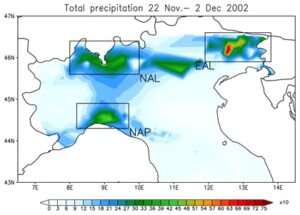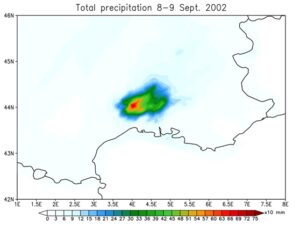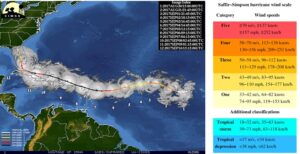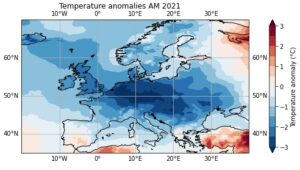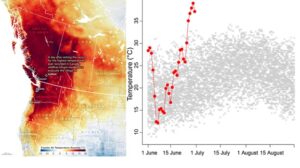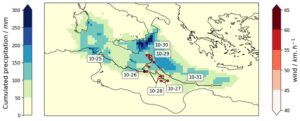Cold Outbreak in Europe
in spring 2021
The spring of 2021 showed anomalously low temperatures across large areas of Europe (see Figure 1). These extreme temperatures likely contributed to impacts in different sectors (energy, health, agriculture). In particular, several frost nights in early April in France caused damage to the regional wine industry as the cold temperatures occurred after anomalously warm temperatures in March, thus, right in the sensitive phase after bud-burst.
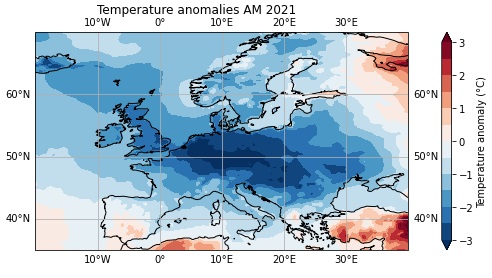
Figure1: Average temperature anomalies in Europe for April and May across Europe. Blue colours indicate that spring temperatures were lower than the long-term (1950-2020) average. (Data: ERA5 reanalysis)
Event definitions
Depending on the research objectives, XAIDA proposes different event definitions.
1. To study the physical drivers of the cold spring of 2021, XAIDA suggests defining the event using a “weather regimes” perspective. Weather regimes denote typical large-scale atmospheric circulation patterns, usually defined using cluster analysis of daily sea level pressure anomalies. XAIDA will define the most relevant spring weather regimes and further identify and analyse the dominant regimes responsible for the cold spring of 2021. This approach will allow us to study the full region of Europe at once, and, by applying varying persistence thresholds, also flexibly assess different relevant time-scales.
2. To study the impacts on the French wine industry of the cold spring 2021, we propose, following Vautard et al. (2021, https://www.worldweatherattribution.org/human-caused-climate-change-increased-the-likelihood-of-early-growing-period-frost-in-france/), to focus on central/northern France [-1°- 5°E; 46°-49°N], covering most of the grapevine agriculture areas of Champagne, Loire Valley and Burgundy. The relevant variables are daily minimum temperatures as well as growing degree days (GDD).
3. To study the more general impacts of the cold spring 2021 on vegetation, we will first develop a memory-aware machine-learning modelling framework of vegetation phenology based on near-surface and satellite remote-sensing data across central and eastern Europe. We will then use the model to estimate impacts of the cold spring on different growing season metrics and vegetation productivity. We will compare results with those of process-based vegetation models.
Objectives
XAIDA aims at :
1. improving the understanding of the physical drivers of this event. We will use causal networks to test and quantify the contribution of different proposed remote drivers (such as ENSO, the polar vortex) on cold spring temperatures in Europe. Cluster analysis will be applied to identify weather regimes.
2. understanding in what way observed and projected temperature changes (minimum, mean, variability and seasonality) can explain trends in frost nights after bud burst using statistical modelling.
3. understanding how observed and projected temperature changes will impact ecosystems during different phenological stages.
 This project has received funding from the European Union’s Horizon 2020 research and innovation programme under grant agreement No 101003469.
This project has received funding from the European Union’s Horizon 2020 research and innovation programme under grant agreement No 101003469.

